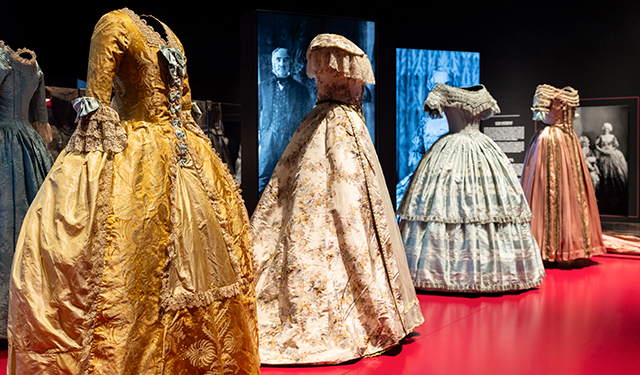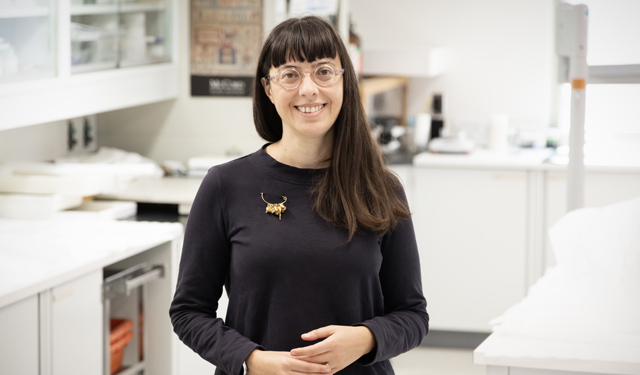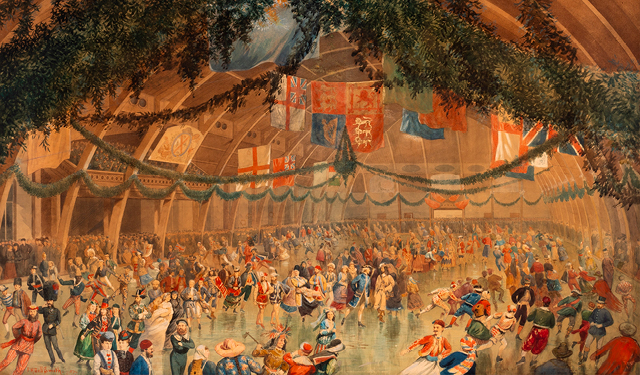[Day 2] Costume Balls: The Symposium
A wide range of approaches to the unparalleled material and visual legacy featured in the exhibition Costume Balls: Dressing Up History, 1870-1927.
March 21, 2025
The extensive historical record of the practice of dressing up assembled in the exhibition documents the minutia of lighthearted moments of life a century and more ago. Yet matters of far greater historical significance continue to be unsettled through the study of a phenomenon so ephemeral and seemingly inconsequential. What current questions have arisen from deep engagement with the material? How has that process opened up new methodological terrain?
The McCord Stewart Museum’s specialists but also curators, artists and authors share new learning derived from the full spectrum of the process of creating the exhibition, from the slow curatorial process of identification and analysis of the extant garments and visual culture, through the subsequent rethinking of our objectives for conservation interventions, to addressing historical injustices in impersonations of Indigeneity.
Keywords: Museology | Textile conservation | Material culture | Indigenous cultures | Costume history | Photography history | History of Canada and Quebec (19th century) | Exhibition curation.
This recording includes the talks and the eight talks from March 21, 2025. View the day’s program below, and browse the video using the available chapters to watch the session of your choosing.
About the exhibition Costume Balls
Creating the exhibition Costume Balls: Dressing Up History, 1870-1927 is the result of a monumental effort. Explore and meet the Museum’s teams of experts and learn more about their work and their discoveries through blog articles, video interviews, behind-the-scenes photos, and much more!
Session 3 – Building Knowledge Through Conservation
Refashioning Conservation Practices
Moderated by Caterina Florio, Head, Conservation
[ 0:00]
The 2024-2025 Costume Balls: Dressing Up History, 1870-1927 exhibition gave the McCord Stewart Museum’s Conservation team an exceptionally complex and wide-reaching assignment. The challenge of studying and preparing the exhibition of a variety of garments, accessories and objects from all the Museum’s collections created a unique opportunity for research, reflection, and creative problem solving. The ephemeral nature of the artefacts, the distinct character and history of each one, as well as the atypical abundance of archival sources are some of the aspects of this collaborative project that made it so enriching.
An assortment of Indigenous regalia and belongings worn as costumes is also featured in this exhibition. However, the conservation approach for these items considered a set of ethical concerns different from those employed for the 41 fancy dress ensembles.
Although the combination of elements in this exhibition has been unique, the knowledge we have acquired has advanced our overall conservation practice by incorporating ethical and practical tools derived from working with collections of very different natures.
After the Ball: How Archival Photographs Influenced the Conservation Treatment of Costumes
Moderated by Caterina Florio, Head, Conservation
Sonia Kata, Conservator
[ 49:30]
A unique aspect of the conservation work for the exhibition was the ability to consult archival materials depicting many of the historic costumes, particularly photographs of ball-goers wearing these very ensembles from a century ago or more. These archival images were incredibly useful resources for our present conservation treatments as they showed us the original, or at least previous, state of the costumes when they were worn to fancy dress balls, although the garments have since changed due to alterations, loss, and deterioration over time. However, the course of treatment was not always the same for all costumes. While some costumes could be restored to better resemble their previous state through repairs, fills, and reproductions based on the archival photographs, other costumes could not, due to significant alterations or other conservation considerations. In either case, the archival images provided valuable, rare insight into the costumes’ state of preservation and history of use that would have otherwise remained unknown.
Dressing Up Mannequins, 2021 to 2024
Moderated by Caterina Florio, Head, Conservation
Caroline Bourgeois, Conservation Assistant
[1:24:00 ]
Over a period of almost three years, more than 40 outfits selected for the exhibition—all of them unique and irreplaceable—were mounted by two members of the Conservation team specialized in costume mounting. This presentation looks at how these costumes were mounted in accordance with the highest conservation standards. The variety of silhouettes, the fragility of the sometimes-incomplete costumes, and the wealth of visual references helped guide our actions. Constantly engaging in periods of reflection and discussion, the team meticulously conducted many tests and used its expertise and creativity to create several reproductions. The result was memorable: the most ambitious costume-mounting project the Museum has ever undertaken.
Reviving the Splendour of a Tudor Lady Costume: A Collaborative Approach to Conservation and Mount Making
Moderated by Caterina Florio, Head, Conservation
Camille Lafrance, Conservator and Amélia Desjardins, Technician, Conservation
[2:02:16 ]
For the exhibition, the Conservation department carried out the treatment and mounting of a Tudor Lady costume with the goal of reviving its original appearance based on historical photographs from the collection. The midnight blue velveteen gown is heavily embellished with faux pearls, and has a matching headdress, bag, and shoes.
Despite being nearly complete, the ensemble was missing its embroidered underskirt, and the velvet overskirt lay in a deconstructed state. Time had also deteriorated the costume’s splendour as the faux pearls were found to be extremely fragile, actively breaking like eggshells, and numerous beads were lost. Due to its condition, the costume could not be displayed in the exhibition without treatment.
This project prompted a symbiotic collaboration between conservators and costume mount makers as the conservation treatments needed to be carried out in stages, in sync with the construction of the custom mount. To restore the Tudor Lady to her original splendour, a digitally printed reproduction of the missing underskirt was created, the overskirt was reconstructed, all the faux pearls adorning the costume were stabilized, and more than a hundred missing beads were replaced.
Session 4 – Dressing Up Colonial Violence
Impersonating Indigeneity: The Oppressor Dressing Up as the Opressed
[2:33:10 ]
The majority of racialized impersonations observed at historically themed costume balls during a certain era in Canada were of Indigenous people. Popular visions and fantasies of the imaginary “Indian” therefore dictated how participants appropriated the image of the other: discrepancies, cultural amalgams, inaccuracies and even the destruction of Indigenous objects were all considered acceptable.
A closer look at the identity of some of the individuals thus costumed has revealed their social positions were far from innocuous; they included an Indian agent, a bureaucrat and superintendent of Indian Affairs, and a military officer during an Indigenous uprising. In other words, these powerful and influential colonial representatives wore the actual clothing and cultural property of the societies that they were actively working to eradicate.
Professional studio portraits as well as the archival documents and object collections of Hayter Reed, now preserved at the McCord Stewart Museum, provide a wealth of clues to the provenance and history of many of these objects that are now part of Canadian museum collections.
Colouring Racist Tropes
Sara Serban, Conservator
[ 3:28:12]
In adherence with the historically themed groups set out for Lady Aberdeen’s 1896 fancy dress ball, several guests appeared as real or imaginary “Indian” characters. Many of their costumes incorporated Indigenous-made garments and regalia collected by Hayter Reed, then serving as the Deputy Superintendent General of Indian Affairs. Guests pieced together their ensembles with often-unrelated items, oblivious to the cultural and geographical inconsistencies in provenance. Objects were dismantled or altered to be repurposed in the creation of a grotesque pastiche of “Indian”-ness. The conservation process to prepare for this exhibition involved an in-depth examination of components used in several costumes known to have been worn by some of the guests, as well as the identification of objects not previously connected to the ball.
Between Myth and Reality: The Story of a Headdress
Guislaine Lemay, Curator, Material Culture
[4:08:53 ]
Several years ago when doing some research in the Notman Photographic Archives, I came across two photographs of a man dressed for an 1865 costume ball in an outfit composed of various Indigenous creations, including an iconic headdress that is now part of the McCord Stewart Museum’s collection. These images were the impetus for a fascinating investigation of the headdress and the historical figure associated with it. The history of this object, from its creation to its inclusion in the McCord Stewart Museum’s collection, includes a series of revealing gaps. This culturally significant Indigenous object became, in turn, a collector’s item, then a costume accessory and vehicle of nationalist propaganda. Examined from the perspective of both reality and myth, it is an eloquent reminder of the colonial mindset focussed on the oppression, exclusion and dispossession of First Peoples and the appropriation of their cultures and struggles in order to legitimize a national myth.
The Perfect Villain: Hayter Reed and Valley of the Birdtail
Douglas Sanderson (Amo Binashii), Andrew Stobo Sniderman, Co-authors, Valley of the Birdtail
[ 4:43:06]
Hayter Reed is probably the greatest villain in Canadian history you’ve never heard of. Who was this man, and what does his story mean for this exhibition (and our country)? Join authors Douglas Sanderson (Amo Binashii) and Andrew Stobo Sniderman for a discussion about their acclaimed book, Valley of the Birdtail: An Indian Reserve, a White Town, and the Road to Reconciliation. This book follows multiple generations of two families, one white and one Indigenous, weaving their lives into the larger story of Canada. Hayter Reed is a central character in the story, which includes an unforgettable scene from the historical costume ball held in Ottawa in 1896.
Biographies
Caterina Florio
Caterina Florio, Head, Conservation, joined the Museum in 2021 as the Head of Conservation. Prior to this she was the sole Textile Conservator at the Canadian Museum of History, Gatineau, Canada. Preceding her institutional positions, she gained extensive experience in the private sector as conservation consultant both in Canada and Italy. She guest lectures on textile conservation and preventive conservation at Queen’s University. She is a member of the Canadian Association for Conservation-Reconciliation Working Group (CAC-RWG), she was recently asked to join Ethics Committee of the Canadian Association for Conservation. She has been sitting on the Board of Directors of North American Textile Conservation Conference since 2017.
Jonathan Lainey
Jonathan Lainey, Curator, Indigenous Cultures, has a background in anthropology and an MA in History from Laval University. His research interests include the social, political and cultural history of the Indigenous Peoples of Quebec and Canada as well as the history of objects and collections over time. Jonathan is a member of the Huron-Wendat Nation of Wendake.
Sonia Kata
Sonia Kata, Conservator, specializes in costumes and textiles, has a BA in Art History from the University of Guelph and holds an MA in Conservation, Artifacts Specialization, from Queen’s University. She belongs to, and volunteers with, the Canadian Association for Conservation (CAC) and is a member of the Canadian Association of Professional Conservators (CAPC), with an accreditation in textile conservation.
Caroline Bourgeois
Caroline Bourgeois, Conservation Assistant, specializes in the design and production of museum-quality mannequins. She studied dress design at Collège Marie-Victorin, set and costume design at the National Theatre School of Canada and museology techniques at Collège Montmorency. A costume designer in the performing arts for many years, she joined the Museum team over 20 years ago.
Camille Lafrance
Camille Lafrance, Junior Conservator, holds a B.A. in Historical Sciences and Heritage studies from Université Laval, and a master’s in Textile Conservation from the University of Glasgow. Since her graduation, she worked as a textile conservator in Montreal before joining the City of Calgary as the new Public Art Associate Conservator.
Amelia Desjardins
Amelia Desjardins, Conservation Technician specialized in costume mounting, holds a MLitt in Dress and Textile Histories from the University of Glasgow. Her strong interest in fashion history is complemented by her practical experience in costume construction. She particularly enjoys the creative challenges of designing custom mounts and mannequins, researching the various materials used and developing techniques for the safe display of garments and textiles.
Sara Serban
Sara Serban, Conservator, loves to research and physically explore the materials and stories behind the objects in our collections. She holds a Master’s in Art History from Concordia University and a Master’s in Art Conservation from Queen’s University.
Guislaine Lemay
Guislaine Lemay, Curator, Material Culture, joined the Museum in 1992, working primarily with the Indigenous Cultures collection. She studied anthropology and archaeology and holds an MA in ethnohistory from Université de Montréal. In 2019, she was named Curator of Material Culture, a collection created following the merger of the McCord Museum and the Stewart Museum.
Douglas Sanderson
Douglas Sanderson (Amo Binashii) is Beaver Clan, from the Opaskwayak Cree Nation. A Fulbright Scholar, he now holds the Prichard Wilson Chair in Law and Public Policy at the University of Toronto Faculty of Law. Professor Sanderson has served as Senior Advisor to the Government of Ontario, in the offices of the Attorney General and Aboriginal Affairs.
Andrew Stobo Sniderman
Andrew Stobo Sniderman is a writer, lawyer and Rhodes Scholar from Montreal. He has written for the New York Times, the Globe and Mail and Maclean’s. He has also argued before the Supreme Court of Canada, served as the human rights policy advisor to the Canadian Minister of Foreign Affairs, and worked for a judge on South Africa’s Constitutional Court.



